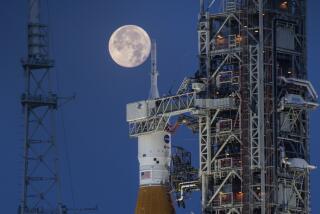NASA plans permanent moon base in 20 years
- Share via
An international team of astronauts will be living and working at a permanent moon base to be built at one of the resource-rich lunar poles within two decades, NASA announced Monday.
Earth’s first off-world colonists will cruise the surface in a lunar lander that will function like a low-gravity pickup, possibly journeying to the dark side to build the most ambitious collection of observatories ever constructed, NASA said.
The announcement of NASA’s vision to build a permanent scientific research station on the moon represents the space agency’s first outline of its plans once it reaches the moon, scheduled no later than 2020.
“We will begin with short missions. Then we will build up to the point where we are staying 180 days, and then we will have a permanent presence,” Doug Cooke, deputy associate administrator for exploration systems, said at a news conference at Johnson Space Center in Houston. The base could be operational by 2024, officials said.
In 2004, President Bush announced the Vision for Space Exploration, which proposed a return to the moon by 2020, as the first step to an eventual manned mission to Mars. NASA has since embarked on a $100-billion-plus program to design a new launch system and crew vehicle capable of carrying four astronauts to the lunar surface. To free up money, NASA will mothball the space shuttles by 2010.
Until now, it was unclear what NASA had in mind for the moon.
“We’re going to go after a lunar base,” said Scott Horowitz, associate administrator for exploration systems. “This is a very, very big decision; one of the few where the science and exploration communities agree.”
Space science advocates have complained that money for basic research is being raided to pay for manned spaceflight, which they feel is costly and of questionable benefit when robotic explorers can perform many of the same tasks less expensively.
In choosing to locate the moon base at either the north or south pole, NASA was persuaded by three factors. One, the sites are relatively unexplored. Two, temperatures are more moderate there than in the searing heat of the equatorial bright side and the numbing cold of the dark side. Lastly, previous moon missions detected unusual amounts of hydrogen at both poles. Some scientists have speculated that this could be traced to hidden ice deposits, a potential source of water.
Australia, Canada, China, Europe, Japan, India and Russia have expressed interest in participating, NASA said.
*
john.johnson@latimes.com
More to Read
Sign up for Essential California
The most important California stories and recommendations in your inbox every morning.
You may occasionally receive promotional content from the Los Angeles Times.










